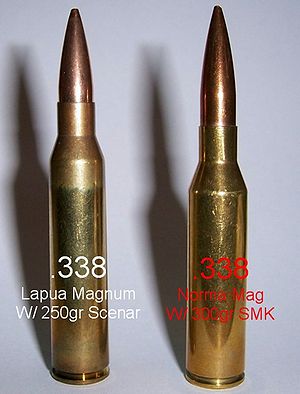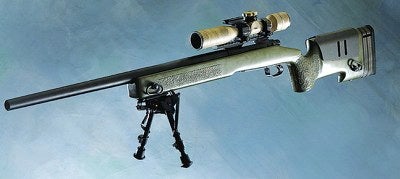The US Military is looking for a system to replace the existing bolt-action SOF Sniper Systems M40, M24 and MK13 which are all based on Remington 700 actions.
One of the key requirements for this system that differentiates it from the existing 7.62x51mm NATO and .300 Win. Mag. sniper systems is that it needs to reach out to 1500 meters with MOA accuracy. Armed forces around the world have long recognized the need for a system that can reach out further than the 7.62mm NATO but is lighter than .50 BMG rifles. Many have adopted the .338 Lapua Magnum chambered rifles to fill this niche. The .338 Lapua Magnum was originally a US Military project but it lost traction and the .300 Win. Mag. is currently used for longer range shooting. The .300 Win. Mag. lacks downrange energy and the lighter projectiles mean greater wind drift at long range (1000 – 2000 yards).
The current Precision Sniper Rifle, as at March 2009, are as follows.
1) The system shall be chambered to safely fire factory produced “non-wildcat” Small Arms Ammunition Manufacturing Institute (SAAMI) or Commercial European standard (CIP) ammunition.
This eliminates some of the fancy odd-ball caliber long range cartridges such as the .408 Cheyenne Tactical (CheyTac). The most obvious choice is the before mentioned .338 Lapua Magnum. The cartridge has been around for a while and manufactures know how to get the most our of the cartridge. Another alternative is the .338 Norma Magnum which is only coming into production this year. It is similar in length to the .338 Lapua but has a slightly shorter and fatter case so it can use heavier and longer bullets which have a higher ballistic co-efficient.

.338 Lapua vs. .338 Norma Mag. Photo from Wikipedia.
2) The action can be either manually or gas operated and available in left and right hand versions.
I think most, or all, entries will be bolt-action rifles. They are easier to make accurate, lighter and more reliable than autoloading rifles. The advantage of a semi-auto is of course rate of fire, but this is not a requirement for this weapons system.
3) With primary day optic and ammunition the system shall provide 1.0 MOA from 300 to 1500 meters (in 300 meter increments) when fired from the shoulder or an accuracy fixture in nominal conditions. This is further defined as 1 MOA Extreme Vertical Spread for all shots in a 10 round group at the stated distances.
1500 meters = 1640 yards.
The rifle is fired from a rest and 80% of the fifty 10 round groups need to be 1 MOA. Note that the MOA is measured only for the vertical spread which eliminates the effects of wind on the measured accuracy. 1 MOA spread is over 10 round groups is much harder than getting 1 MOA for a standard 3 round group!
4) Mean Rounds Between Failures (MRBF) shall be 1000 rounds.
5) The system shall have an overall length no greater than 52″ in full configuration / extended excluding suppressor with a single component no greater in length than 40″.
6) The system shall weigh no more than 18 lbs with a 12:00 MilStd 1913 rail and a loaded magazine with 5 rounds.
7) The system shall be capable of operator breakdown into major components in less than two minutes.
The barrel also needs to be able to be swapped out by the operator within 20 minutes.
8 ) The system will assemble from the major component breakdown in less than two minutes by the operator.
9) The system will assemble from breakdown with no change in weapon zero.
10) The system will have an integral MilStd 1913 rail at the 12:00 position, the rail will be capable of maintaining bore sight alignment and weapon zero while conducting routine firing combined with combat movement and operational training drills.
These are all pretty standard requirements. One other test than will be performed will be drop tests with loaded rifles. The rifles are expected to be able to be dropped 1.5 meters at various angles without firing the chambered cartridge.
Overall they seem very sensible requirements. It will be interesting to see how this competition progresses.
 Your Privacy Choices
Your Privacy Choices
